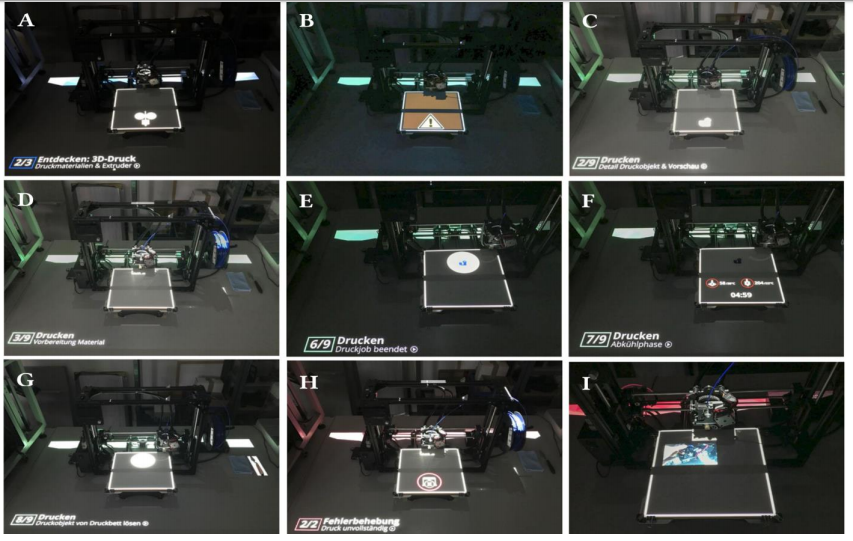In a new paper, German researchers Thomas Ludwig, Michael Doll, and Christoph Kotthaus address a very important topic in society today—how to deal with complex technology we may not quite understand and may have trouble incorporating it into our work or personal lives. With 3D printing, the authors theorize that users could look forward to understanding information better through visualization. Project mapping is used here to create innovative interfaces for required appropriation.
The target group in this study is ‘people who have little to no technical expertise.’ They consider this to be an important dynamic as progressive technology continues to be introduced and is prevalent. With sociable technologies, ‘hardware-integrated affordances’ can be used to accompany and enhance technology documentation and communication; in fact, the support can be directly built-in to the hardware of the technology itself. Projection mapping is one kind of augmented reality (AR), with images projected onto an object—like we enjoy in entertainment and gaming; however, AR may also be able to play a substantial role in complicated technology.
Projection mapping with 3D printing allows users to communicate with their hardware in a sense, along with ‘doing’ of configuration along with making sense of technology.
“A firm grounding of appropriation in doing—that is, in using the respective artifact and transforming it if needs be—can be viewed as being akin to do-it-yourself and maker perspectives, which utilize similar frames of mind and strategies when approaching new technologies,” state the researchers.
They do not consider it enough to center this study around software, however, as ‘physical technology’ must be considered. The design must be thoughtful, with a clear understanding of the users and their typical environment. Ultimately, the hope is to make devices sociable—using ‘sociable technology.’ Spatial augmented reality is also known as projection mapping, turning anything into a digital display—which you may have seen previously in art, advertising, entertainment, and more. The researchers designed a projector-based projection for realizing information, an audio system for realizing auditory information, and a control tablet to act as a graphical user interface—and system control.
“Depending on the 3D printer status and on the interaction triggered by the user, we implemented a communication structure between the tablet and the projector to control the projected content. The primary task of the projector control was providing reactive video output,” stated the researchers. “Consequently, the control tablet had to transmit to the projector control which video file was to be played, paused, or ended at what point in time.”
The team used a Lulzbot TAZ 5 for creating the ‘technical implementation,’ finding during their research that many of the students were hesitant to use 3D printing. Some were afraid due to the value of the 3D printers, while others were worried about operational expense—or damaging the machine altogether.
“As all our participants were able to perform a successful 3D print, our evaluation indicates several advantages of using projection mapping for appropriating complex CPS. However, the study was limited by not conducting a comparative usability study without support prior to using our system. In addition, we see a need to further investigate how our results might be applied to other physical machines with a more closed design,” concluded the authors. “Here, one could examine how equipping the inner spaces of machines with several miniprojectors that project videos to its inner parts will perceived by its users.
“As complex CPS are increasingly pushing into the everyday lives of many users, we contribute with innovative insights as to how to apply projection mapping as a new form of user interface for appropriating these technologies. Through our findings, we extend the knowledge of HCI and CSCW discourses around appropriation as well as the design of projection-based interfaces for sociable technologies.”
Projection mapping is just one type of augmented reality, but many others are associated with 3D printing today also, from projects for kids to interactive platforms, and even smart glasses. What do you think of this news? Let us know your thoughts! Join the discussion of this and other 3D printing topics at 3DPrintBoard.com.
[Source / Images: ‘The Printer is Telling Me about Itself: Supporting the Appropriation of Hardware by Using Projection Mapping’]Subscribe to Our Email Newsletter
Stay up-to-date on all the latest news from the 3D printing industry and receive information and offers from third party vendors.
You May Also Like
Printing Money Episode 17: Recent 3D Printing Deals, with Alex Kingsbury
Printing Money is back with Episode 17! Our host, NewCap Partners‘ Danny Piper, is joined by Alex Kingsbury for this episode, so you can prepare yourself for smart coverage laced...
Insights from Cantor Fitzgerald on AM’s Q1 2024 Landscape
A recent survey by Cantor Fitzgerald sheds light on the persistent challenges within the additive manufacturing (AM) industry in the first quarter of 2024. Based on responses from 38 industry...
3D Printing Financials: Xometry’s Scaling up and Strong Start to 2024
Xometry (Nasdaq: XMTR) kicked off 2024 with strong results, boosting its marketplace and technology to new heights. Both revenue and gross margin soared, fueled by an expanding global network of...
3D Printing Financials: Desktop Metal Targets Recovery Amid Net Losses and Revenue Downturn
Despite facing a decline in revenue and the persistent challenges of a tight economic climate, Desktop Metal (NYSE: DM) is making strides toward operational efficiency. The first quarter of 2024...



































